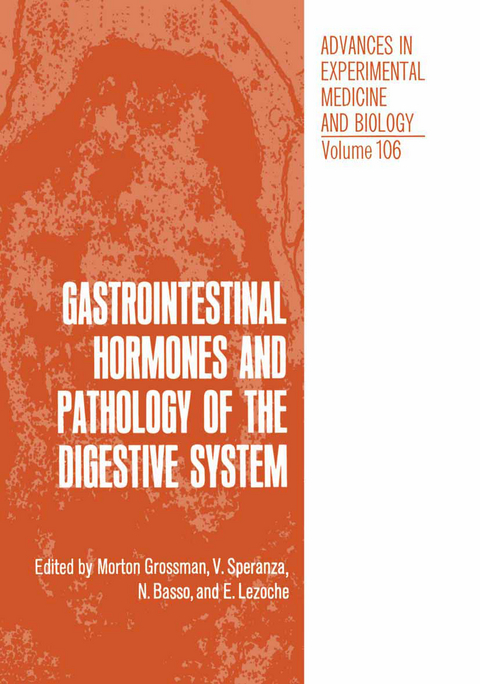
Gastrointestinal Hormones and Pathology of the Digestive System
Springer-Verlag New York Inc.
978-1-4684-7250-9 (ISBN)
The Gastrointestinal Hormones: An Overview.- A Short History of Digestive Endocrinology.- Endocrine Cells of the Gastrointestinal Tract: General Aspects, Ultrastructure and Tumour Pathology.- How Does a Candidate Peptide Become a Hormone?.- Peptidergic Innervation of the Gastrointestinal Tract.- Polypeptides of the Amphibian Skin Active on the Gut and their Mammalian Counterparts.- Paired Immunohistochemical Staining of Gastrin-producing Cells (G cells) and Parietal Cells in Paraffin Sections of Human Gastric Mucosa.- Histamine H2-Receptors and Gastric Secretion.- The Gastrins: Structure and Heterogeneity.- Biological Activity and Clearance of Gastrin Peptides in Dog and Man: Effects of Varying Chain Length of Peptide Fragments.- Different Forms of Gastrin in Peptic Ulcer.- Antral G Cells and Mucosal Gastrin Concentration in Normal Subjects and in Patients with Duodenal Ulcer.- Role of the Small Bowel in Regulating Serum Gastrin and Gastric Inhibitory Polypeptide (GIP) Levels and Gastric Acid Secretion.- Cimetidine Treatment in Zollinger-Ellison Syndrome.- Calcitonin, Parathyroid Hormone and Insulin Concentrations in Sera from Patients with Gastrinoma.- Hormonal Control of the Lower Esophageal Sphincter in Man and Dog: Reevaluation of the Present Manometric Method for Diagnosis of GE Reflux.- Progress in Intestinal Hormone Research.- Trophic Effects of Endogenous and Exogenous Pancreozymin upon the Exocrine and Endocrine Pancreas.- Enteropancreatic Axis.- Pancreatic Polypeptide (PP).- Physiology and Pathophysiology of GIP.- Gastric-Glucagon: Physiology and Pathology.- The Glucagonoma Syndrome.- VIP: the Cause of the Watery Diarrhoea Syndrome.- Secretin Release in Man: Current Status.- Secretin, Gastrin and Pancreatic Bicarbonate Responses to Meals Varying in pH Levels.-Role of the Vagus in Endogenous Release of Secretin and Exocrine Pancreatic Secretion in Dog.- The Effect of Atropine on Secretin Release and Pancreatic Bicarbonate Secretion after Duodenal Acidification in Man.- Immunoreactive Secretin Release and Pure Pancreatic Juice after Duodenal Infusion of Bile in Man.- Somatostatin and Gastrointestinal Secretion and Motility.- The Inhibitory Action of Somatostatin on the Stomach.- Recent Advances in Motilin Research: its Physiological and Clinical Significance.- Glucagon Secretion Induced by Bombesin in Man.- Polypeptides in Brain and Gut: Cholecystokinin-like Peptides.- Motilin-, Substance P- and Somatostatin-like Immunoreactivities in Extracts from Dog, Tupaia and Monkey Brain and GI Tract.- Prostaglandins and Serotonin in Diarrheogenic Syndromes.- Prostaglandins and Gastrointestinal Secretion and Motility.- Radioimmunoassay of Secretin.- Radioimmunoassay of Vasoactive Intestinal Polypeptide (VIP) in Plasma.- Effects of Bombesin and Calcium on Serum Gastrin Levels in Patients with Retained or Excluded Antral Mucosa.
| Reihe/Serie | Advances in Experimental Medicine and Biology ; 106 |
|---|---|
| Zusatzinfo | 32 Illustrations, black and white; X, 326 p. 32 illus. |
| Verlagsort | New York, NY |
| Sprache | englisch |
| Maße | 178 x 254 mm |
| Themenwelt | Medizinische Fachgebiete ► Chirurgie ► Viszeralchirurgie |
| Medizinische Fachgebiete ► Innere Medizin ► Gastroenterologie | |
| ISBN-10 | 1-4684-7250-X / 146847250X |
| ISBN-13 | 978-1-4684-7250-9 / 9781468472509 |
| Zustand | Neuware |
| Haben Sie eine Frage zum Produkt? |
aus dem Bereich


